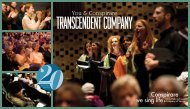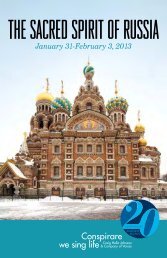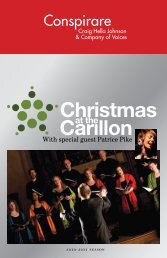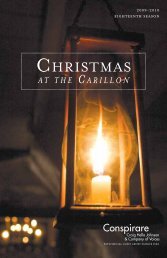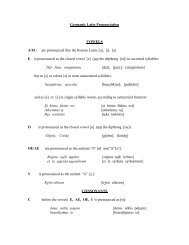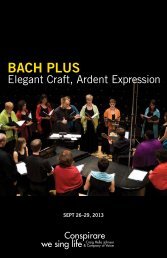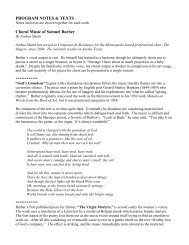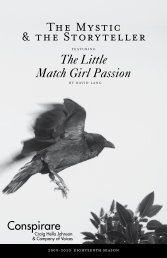Samuel Barber - Conspirare
Samuel Barber - Conspirare
Samuel Barber - Conspirare
- No tags were found...
You also want an ePaper? Increase the reach of your titles
YUMPU automatically turns print PDFs into web optimized ePapers that Google loves.
“The Coolin” takes its name from the curly lock of blond hair at thenape of the neck (which eventually became used as a nickname for aloved one). Of his poem, James Stephens said, “I sought to representthat state which is almost entirely a condition of a dream, whereinthe passion of love has almost overreached itself, and is sinking to amotionless languor.” <strong>Barber</strong> seems to have taken him at his word andthe music is luxuriant and warm. We dwell for a moment at the edge ofthe phrase “And a lip to find out a lip,” before tenderly fading back intothe same music which opened the movement.The first of dawn refresh our eyes.We watch the world grow wide and brightAnd praise our newly risen Light.The winter land receives the year.Her smallest creatures rouse and clingTo swelling roots and buds that stirThe restless air to reel and ring!Alleluia! Alleluia!************Come with me, under my coat,And we will drink our fillOf the milk of the white goat,Or wine if it be thy will.And we will talk until talk is a trouble too,Out on the side of the hill;And nothing is left to do,But an eye to look into an eye,And a hand in a hand to slip;And a sigh to answer a sigh;And a lip to find out a lip!What if the night be black,Or the air on the mountain chill,Where all but the fern is still!Stay with me, under my coat,And we will drink our fillOf the milk of the white goat,Out on the side of the hill!“Easter Chorale” will be performed after “The Lovers.”“Easter chorale” was commissioned in honor of the dedication ofthe massive central tower of the National Cathedral in May 1964and originally appeared as a work for brass and timpani. Later thatyear <strong>Barber</strong> added choral parts on a text by Pack Browning. Thetext features numerous references to nature (a common theme in thecomposer’s work) as a symbol of the risen Christ, which <strong>Barber</strong> enlivensthrough his music while never distracting from the poetry. Robert Kyr’snew version of “Easter Chorale” uses the contrasting sections of thethirteen-player chamber orchestra (woodwinds, brass, strings) to coloreach verse of the text, gradually building in intensity until the finalproclamation rings out in triumphant majesty: “We listen to the liveearth sing/And praise our loving Source and Spring.”The morning light renews the sky.Across the air the birds igniteLike sparks to take this blaze of dayThrough all the precincts of the night.Alleluia! Alleluia!************The sounds of waking fill our ears.We listen to the live earth singAnd praise our loving Source and Spring.The LoversMusic by <strong>Samuel</strong> <strong>Barber</strong>, new chamber version by Robert KyrNotes by Robert KyrWhen Craig Hella Johnson asked me to create a new version of <strong>Samuel</strong><strong>Barber</strong>’s The Lovers for baritone, chamber chorus, and chamber orchestra,I was overjoyed. First, I consider The Lovers (on poetry of PabloNeruda) to be one of the few American choral-orchestral masterworksof the twentieth century. Moreover, I have always felt that it would receivemany more performances in a smaller version that is better suitedto the sublime intimacy of Neruda’s poetry.<strong>Barber</strong> created The Lovers during the years when his longtime romanticand domestic partnership with Gian Carlo Menotti (the acclaimedopera composer) was deteriorating (1969-71), and he was still hauntedby the failure of Antony and Cleopatra at the Metropolitan Opera(1966). His life experience is reflected in the despair of Neruda’s poeticexploration of love (both erotic and spiritual) and its loss, which mightalso relate to his romance with Valentin Herranz, to whom the work isdedicated and who suggested the text to him. (Later, Valentin became<strong>Barber</strong>’s personal assistant and valet until the end of his life.)When you hear the music, imagine the anguish of its composer ashe faced these difficulties and gradually became overwhelmed by hisunconscious wounds and vulnerabilities, which further stoked the firesof love gone wrong. And into this toxic brew, mix his suffering fromthe societal prejudice against homosexuality, as well as his worseningalcoholism.Given this context, one better understands why <strong>Barber</strong> chose Neruda’spassionate song of despair, and why the music connects us so vividlyto a situation that no one can escape. In some sense, our greatest lovesremain with us equally and always – those we kept and those we lost.14 15



